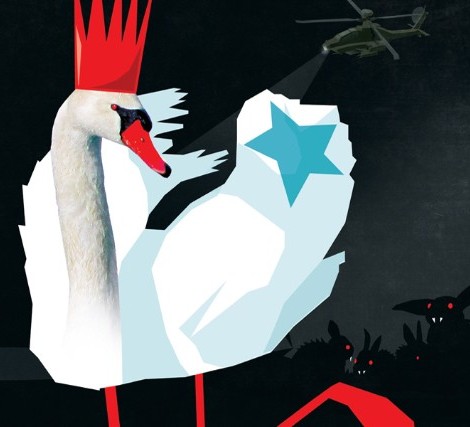Beware of the Western Wall, child
14/8/2012
In their new work, “Black Fairytale”, Oded Graf and Yossi Berg examine the condition of humanity, with the lens focused on the political conflict in Jerusalem
The new work by Oded Graf and Yossi Berg, “Black Fairytale”, opens with the group of dancers standing bunched together at the front of the stage and singing a song of praise to love, to peace, to the rising sun, to hope. This isn’t a colorful group of hippies from the sixties, naively and enthusiastically skipping around in parks under the open sky, but a very European, somewhat gloomy band, dressed elegantly in black, wearing ties, and singing with shining eyes like a choir of believers in a church.
The word “love” is repeated again and again, like a preacher’s repeated motif, like brainwashing, until the soft sound becomes hard, sharp, shrieked like a yelp. So the starting point of the fairytale is not a land bathed in light but a closed place that cries out for the sun.
Graf and Berg examine the condition of humanity in the present, with the lens focused on the political conflict in Jerusalem, the city to which they refer as part of a contemporary fairytale. As in fairytales, Utopia faces Hell, and the transitions between them may be sharp, and as in the stories, the power of love can remove all the landmines and be victorious.
The group of dancers separates and washes the stage with partner swaps. These are quick, virtuosic meetings, resembling a connection, a search for security, but there is no tenderness or intimacy in their movements. The fairytale starts when a dancer holding a microphone tells her mother that she wants to go to a land far, far away – to Jerusalem. There, so she has heard, the skies are blue, the sun shines and the trees are laden with juicy fruit. The mother replies – in words reminiscent of Red Riding Hood’s mother telling her to beware of the wolf in the forest – “But beware, my child, don’t go near the Western Wall.”
And the dancer continues to tell her story, all in clearly pronounced English, accompanying herself with body movements, how without wanting to she found herself at the Wall, as in the scary fairytales, and there she was surrounded by a mass of people dressed in black, their eyes red with hate, and she was forced to climb the wall to escape from them, but at the top she encountered another kind of people dressed in black and their eyes were also filled with hate. And so, she says, she fainted and reached a surrealistic world.
And in her dream, the small touring tent that was placed on the stage, where dancers went in and out as if through a time tunnel, became a monster, moving across the stage space, seeking to swallow everything in its path. And so the work is constructed of layers of dreams, one on top of another, intertwined with each other.
In another scene, the tie-wearing dancers take off their clothes, men and women, with exposed skin gleaming under the lights, wearing only tight black briefs. There is an atmosphere of freedom, of a “make believe” sunlit land. For the first time there are short, intimate meetings between the dancers, who kiss – man and woman, man and man. Everything is possible.
From the clothes they have thrown on the floor, the dancers create a kind of costumed figure; on its head they place shoes that stick out like a demon’s ears, and on the torso that has expanded with layers of clothing, shining like a jewel, is a red light bulb flashing, seeming like a bomb. The figure advances, as if shooting in every direction. The force of evil against the forces of good. And as in the fairytales, perhaps, one of the female dancers melts the evil male dancer with her love and neutralizes the disaster.
Throughout this creation there is a motif that reminds us of preachers asking questions – about life, about good and evil – repeating the question again and again, and the group responds excitedly almost like in a religious ritual. In the final scene, the dancers draw lines on the stage, a kind of roadmap, and walk along them, passing along the same way but not stopping, continuing onwards. It is a kind of map that joins the past to the present, imagination to reality, and in the advancing stream of dancers we can identify Cinderella’s shoe, Red Riding Hood’s cape, a witch’s besom broom, and also a rifle or a ticking bomb.
Throughout this work, the artists present material involving contemporary movements of a familiar kind and the execution is good. But this is not the real issue. The real offering lies in the challenge of dealing with the subject, and in the way that dance, text and singing are combined, and here I think it is right to praise the successful dramaturgy that has created such an intriguing work of art that links contemporary problematic reality with the fairytales of childhood, and shows them in a new light.
– Ruth Eshel, Haaretz

Photo robin Hart